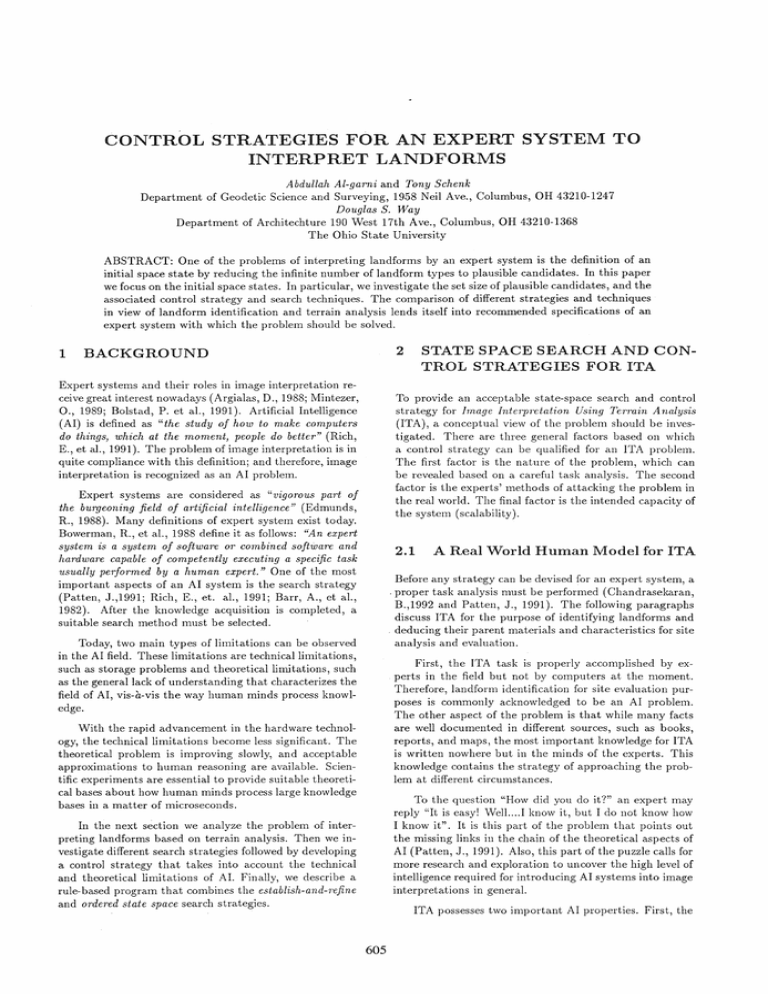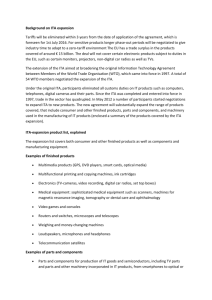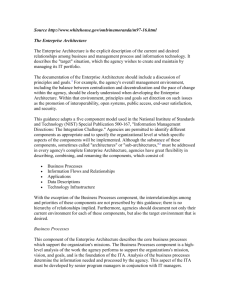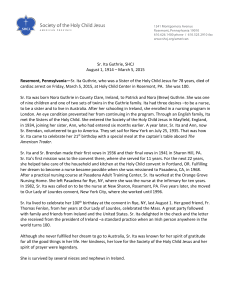CONTROL STRATEGIES FOR AN EXPERT SYSTEM TO
advertisement

CONTROL STRATEGIES FOR AN EXPERT SYSTEM TO
INTERPRET LANDFORMS
Abdullah Al-garni and Tony Schenk
Department of Geodetic Science and Surveying, 1958 Neil Ave., Columbus, OH 43210-1247
Douglas S. Way
Department of Architechture 190 West 17th Ave., Columbus, OH 43210-1368
The Ohio State University
ABSTRACT: One of the problems of interpreting landforms by an expert system is the definition of an
initial space state by reducing the infinite number of landform types to plausible candidates. In this paper
we focus on the initial space states. In particular, we investigate the set size of plausible candidates, and the
associated control strategy and search techniques. The comparison of different strategies and techniques
in view of landform identification and terrain analysis lends itself into recommended specifications of an
expert system with which the problem should be solved.
1
STATE SPACE SEARCH AND CONTROL STRATEGIES FOR ITA
2
BACKGROUND
Expert systems and their roles in image interpretation receive great interest nowadays (Argialas, D., 1988; Mintezer,
0., 1989; Bolstad, P. et al., 1991). Artificial Intelligence
(AI) is defined as "the study of how to make computers
do things) which at the moment) people do better" (Rich,
E., et al., 1991). The problem of image interpretation is in
quite compliance with this definition; and therefore, image
interpretation is recognized as an AI problem.
To provide an acceptable state-space search and control
strategy for Image Interpretation Using Terrain Analysis
(ITA), a conceptual view of the problem should be investigated. There are three general factors based on which
a control strategy can be qualified for an ITA problem.
The first factor is the nature of the problem, which can
be revealed based on a careful task analysis. The second
factor is the experts' methods of attacking the problem in
the real world. The final factor is the intended capacity of
the system (scalabili ty ).
Expert systems are considered as "vigorous pad of
the burgeoning field of artificial intelligence" (Edmunds,
R., 1988). Many definitions of expert system exist today.
Bowerman, R., et al., 1988 define it as follows: "An expert
system is a system of software or combined softuwre and
hardware capable of competently executing a specific task
usually performed by a human expert." One of the most
2.1
A Real World Human Model for ITA
Before any strategy can be devised for an expert system, a
. proper task analysis must be performed (Chandrasekaran,
B.,1992 and Patten, J., 1991). The following paragraphs
discuss ITA for the purpose of identifying landforms and
. deducing their parent materials and characteristics for site
analysis and evaluation.
important aspects of an AI system is the search strategy
(Patten, J.,1991; Rich, E., et. al., 1991; Barr, A., et al.,
1982). After the knowledge acquisition is completed, a
suitable search method must be selected.
Today, two main types of limitations can be observed
in the AI field. These limitations are technical limitations,
such as storage problems and theoretical limitations, such
as the general lack of understanding that characterizes the
field of AI, vis-a-vis the way human minds process knowledge.
First, the ITA task is properly accomplished by experts in the field but not by computers at the moment.
Therefore, landform identification for site evaluation purposes is commonly acknowledged to be an AI problem.
The other aspect of the problem is that while many facts
are well documented in different sources, such as books,
reports, and maps, the most important knowledge for ITA
is written nowhere but in the minds of the experts. This
knowledge contains the strategy of approaching the problem at different circumstances.
With the rapid advancement in the hardware technology, the technical limitations become less significant. The
theoretical problem is improving slowly, and acceptable
approximations to human reasoning are available. Scientific experiments are essential to provide suitable theoretical bases about how human minds process large knowledge
bases in a matter of microseconds.
To the question "How did you do it?" an expert may
reply "It is easy! Well. .. .I know it, but I do not know how
I know it". It is this part of the problem that points out
the missing links in the chain of the theoretical aspects of
AI (Patten, J., 1991). Also, this part of the puzzle calls for
more research and exploration to uncover the high level of
intelligence required for introducing AI systems into image
interpretations in general.
In the next section we analyze the problem of interpreting landforms based on terrain analysis. Then we investigate different search strategies followed by developing
a control strategy that takes into account the technical
and theoretical limitations of AI. Finally, we describe a
rule- based program that combines the establish-and-1'efine
and orde1'ed state space search strategies.
ITA possesses two important AI properties. First, the
605
This paper assumes a large system with definite number of goals. Figure 2 illustrates the properties of the task
of ITA. The general configuration of the triangle indicates
the coarse-to-fine property of the problem while the small
squares inside the triangle portray the decomposability of
the problem to smaller individual concepts. Depending on
the granularity or resolution intended by the system, the
reached and verified concept could be a single or several
concepts. In fact, the ITA problem is methodological in
nature (Avery, T. and G. Berlin, 1985) and modular in
concept. The modularity of the problem is explained next
as a set and subset concept.
problem consists of many concepts that can be decomposed, within a general domain, into many subconcepts
according to certain criteria (Hoffman, R., 1989a; Mintzer,
0., et al., 1984; Mintzer, 0., 1988; Strahler,N., 1981; Way,
D., 1973; Zuidam, R., 1985). The other property of the
problem is the way the solution is obtained by a human
expert. At the beginning the solution is very general; then
it is refined until specific conclusions are reached (Way,
D., 1992). This property, called coarse-to-fine property,
is more obvious in relatively hard and very hard (complex terrain) environments. The coarse- to-fine property
is known in AI fields as hierarchy classification property.
These two properties of the problem are indicative and
to a large extent determinative of what control strategies
should be devised in AI systems that are to be developed
for the ITA problem.
2.2
Using set theory, let the general concept of the above task
be denoted by Gg , and let the first level of the decomposable concepts be a set Ll where
Ll = {Gl l , G12 , ... G1n } such that:
Gg :::) Gll , G12 , .... , GIn'
Then, it is necessary and sufficient for the ITA problem to
be decomposable if it has:
1. Gg i- 0.
2. Gg :::) Gl l , GI2 .... ' GIn
3. Gij n Gik = {0}, where j i- k
Now, let
Gll , G12 , ... GIn
Analysis of processing more than forty models in the
field, processed by a recognized expert, indicated that a
human expert analyzes the ITA problem in a consecutive
logical way. Figure 1 shows a human analysis model for
the problem. The model consists of five major phases or
modules:
1. Adjustment module
2. Initial settings module
3. Transition phase module
4. Hypotheses module and
5. Verification module.
Adjustment Module
Initial
~ Settings
Module
~
ITA Decomposability Property
Transition
Module ~
Hypotheses
Module
Verificatio
n&
~ Conclusion
Module
Figure 1: ITA Modularity as Processed by Human Experts in the Real World.
which are denoted previously by L 1 , presents the coarsest
level of the concept Gg ; then
Ll EGg.
Many experts do not realize that they reason in this
sequence. For instance, experts note the fourth and fifth
phases but, often, not the first and third phases. This
chain of logical analysis is very important to be realized
by the Knowledge Engineer (KE) due to its essentiality in
qualifying certain state-space search strategies over others
for the ITA problem.
000000
In the real world, an expert is sitting in his office and
ready to provide interpretations and consultations for his
customers. This is what an expert expects. However,
he cannot predict what a customer's image will contain.
That is, the expert might work on tens of stereo pairs,
each containing different features, terrain, and characteristics. Analogously, an AI system for the ITA task should
be ready for any type of tasks for ITA, but within the
prespecified limits of the system. For instance, if the system was developed to identify thirty landforms on earth,
it should be able to define any of these landforms at any
time without an a priori expectation of which landform it
will face with the next customer. This ability calls for an
engineer to develop a systematic or methodological way of
ITA that is general enough to cover the whole spectrum
of the task.
Large Triangle Portrays The Coarse-to-Fine Concept
Small Squares Indicate Individual Concepts
Figure 2: ITA With Coarse-to-Fine Concept and
Decompotion Property.
606
subconcepts are derived until the solution is reached. Figure 3 illustrates the filtration concept and the notion of
sets and subsets of the ITA problem. (The reader is referred to Childress, R., 1974; Kaplansky, 1., 1972; Eisenberg, M., 1971; Reed, G., 1977 for more information about
set theory.)
By the same analogy, Ll may be further decomposed.
Let
= {C21,C22, ... ,C2d
L2
be the second level of the concept that is filtered from the
first level. In a similar fashion:
Cg ~ C21 , C22 , ... , C2k ·
Then the set relations
L2 ELI; and
C21 n C 22 ... n C2k = {0}, where L2
=1=
The explained sets and subsets portray the solution
path and should not be confused with the general problem configuration, which may appear quite opposite in a
diagram. To illustrate the difference, Figure 4 combines
the whole concept. More intention should be paid to the
setting of the large triangle as opposed to the settings of
the interior, smaller, triangles. Conceptually, these two
triangles are similar in that both have coarser knowledge
up and finer knowledge down. The difference, however, is
in the final outcome of each. The larger triangle presents
the whole spectrum of the problem. That is, all landforms
existing on earth that the system may identify are listed at
the bottom of the large triangle. In contrast, the smaller
triangle presents only those landforms that are of interest
and appear on a particular image. Therefore, smaller triangles represent a solution while the larger one represents
the whole problem (domain). The individual events represented by the small triangles are eventually summed up
to constitute the whole population.
0
are held.
The same decomposition continues for the concept until Lg is reached, where Lg denotes the resolution level
which contains the goal node:
L3 = {C31,C32, ... ,C3d
= {CgI, Cg2 , ... , Cgs }
Lg
where 9
> r > ... > 1. Then
Lg E Lg- 1 E ... ELI.
I
I
Cg
a a a
a
B
I
Qualification Function (Q1)
2.3
Based on the previously mentioned properties and theories of the nature of ITA problem, it is fair to say that
in the real world the absolute initial states of the problem are unknown at the first few moments. This general
statement immediately implies unknown goals at the initial state space. For instance, an analyst is told to define
all existing landforms in a stereoscopic pair of images. Before looking at the pair, the analyst has no way of knowing
where to start and what to expect. This momentary vagueness is soon adjusted according to the adjustment module
based on certain criteria in the very few starting steps of
the interpretation processes.
I
Iv
a
a
EJ B
I
Qualification Function
Search Flow of The Human Model
I
This part of the problem (an unknown hypotheses)
calls for an immediate forward tracking of the solution
by the expert system (initial setting module). Likewise,
the human expert is unconsciously conducting a forward
search or tracking at his initial settings and scanning of
the problem. As soon as the human expert handles the
images, looks at them, and reads them, he narrows the
problem and defines his starting points or what is called
initial state-space. As mentioned previously, control strategy should be in a close compliance with human search
strategies. Accordingly, at this level of discussion, the first
conclusion is that the initial search control strategy should
be developed to work in a forward-tracking (knowledgedriven) manner.
The next step of search control strategy conducted by
human experts is to do further careful analysis based on
well established criteria to prune all irrelevant concepts
from the whole space, sticking only the candidate concepts.
This middle level of the search can be either forward- or
backward-tracking. The tracking method depends on how
the expert attacks the problem to decompose it into subconcepts. If he has already developed a certain broad hy-
Figure 3: The Concept of Sets and Subsets of The ITA
Problem.
Denote the level qualification factors that an expert
uses to move from one level to the other by Ql, Q2, ... , Qg .
These qualification factors are the criteria based on which
607
pothesis about several subconcepts, then he is doing a tem, porary backward tracking of this hypothesis in his mind.
But if the problem is still too vague, a forward tracking
may continue because the expert has not yet developed
any goal to verify (transition phase module).
viewpoint of image interpretation using terrain analysis.
This paper concerns the third component.
The basic characteristics that any good control strategy should possess are the ability to maintain a dynamic
character (motion) of the state-space and the ability to
provide a systematic behavior to the whole space (Rich,
E. and K. Knight, 1991; Chandrasekaran, B., 1990). The
mobility property of any strategy provides the avenues to
eventually reach the solutions to the problem under consideration. On the other hand, the systematic property of
any strategy prevents the undesirable repeated exploration
of useless state-space several times before the solution is
reached (Patten, J., 1991).
.
The third and last step achieved by the expert is to
rank the possible and most promising concepts (landforms)
in the image and to start to verify them one (or several)
at a time (hypotheses module). This implies that, at this
level of image interpretation process, a very determined
hypothesis (goal or concept) is clearly defined in the expert's mind. Until the goal is verified or disapproved, the
whole process is a goal-oriented (or a goal-driven) process.
The AI system must follow the human way of attacking
the problem and act accordingly. From here on, the rest
of the process of the control strategy should use backward
tracking for the knowledge search since some goals are developed (verification module). Since there is no absolute
forward tracking in AI, it is important to realize that there
is a dummy or transitional parameter so that the datadriven search can progress (Chandrasekaran, B., 1992).
The content and the organization of the system's knowledge base are influenced by the selected control strategy.
The control strategy of a system becomes very obvious in
tasks that use operators to modify the problem concepts in
a multiple task-domain situation. The ITA problem needs
several operator sequences at every level so that the next
move is conducted intelligently. This property of the probResolution Level Increases
Level
B
Level
E
Figure 4: Problem Domain Setting vs. Solution Path Settings.
2.4
lem exposes two different types of search theories. The
first theory is called blind search theory or control strategy (e.g., breadth-first and depth-first search) (Barr, A.,
et al. 1982; Rich, E. and K. Knight, 1991). The second
theory is called heuristic search theory or strategy (e.g.
ordered state-space or best-first search) . These theories
are illustrated by presenting three examples so that proper
conclusions about the suitability of these theories to the
Qualifications and Implementations
of Strategies
Like any other AI problem-solving system, the ITA expert
system consists of three main components: a database, a
set of operators, and a control strategy. Current research
is carefully investigating all three components from the
608
ITA problem are reached.
2.5
Blind State-Space Search Strategies
2.5.1
Breadth-First and Depth-First Search Strategies
ever, that this ,conclusion is based on pure blind search
methods in which no criteria are developed to qualify the
promising nodes to be explored amongst the list in every
level in the state-space problem. When a set of qualifying
criteria is developed for these methods, a new and more
sophisticated state-space search and control strategies are
obtained, which are closer to the human way of reasoning
about the
Breadth-first search strategy expands the concepts (nodes)
according to their proximity to the starting node or concept. Arcs can be used as a measure for node proximity.
Accordingly, all possible operator sequence of length n is
considered before any sequence of length (n + 1). In the
ITA problem this strategy declines in value as the system's
scalability increases. If careful planning is not practiced
before developing the expert system, this problem is dangerous for it may not be very obvious at the initial stages
of developing the system.
2.5.2
Heuristic State-Space Search for ITA
Heuristic control strategy assesses various operator sequences
and signalizes or instantiates the most promising sequence
(Barr, A. and E. Feigenbaum, 1982). In fact, heuristic
search strategies use certain criteria to direct the search
in the state-space of the problem. Based on these criteria and based on the nature of the ITA problem, heuristic
state-space search and a combination of forward and backward chain reasoning constitute a set of control strategies
that meet the conceptual aspects of the ITA problem; and,
therefore, this set is implemented by this study for this
problem. This type of search is justified by many facts,
some of which were described previously and some of which
are discussed next.
As it should be understood, expert systems are developed incrementally (Jackson, P., 1986). That is, system
development passes through three phases. The first phase
is the prototype development of the system. Most often
this phase can use the breadth-first search strategy, which
can be of great advantage. The next phase is a transition phase. In this phase, the attributes, parameters, and
number of landforms to be treated increase. At this phase
the system's slowness becomes evident. The third phase of
the development is the hybrid system phase. In this phase
the problem spectrum is almost completely covered by the
system.
Representing the knowledge in the expert system according to the logic of the human expert is a prerequisite
in developing control and search strategies for the system.
This prerequisite stems from two essential factors. First,
the expert has to understand the KE's real attempts to
model the expert's own expertise and, as a result, the expert gains the confidence to test and evaluate the system's
success based on his knowledge and familiarity with the
main workings of the system. In relation to this issue,
the end user's acceptance of and confidence in the system are more likely to be attained if the knowledge representation and control strategy schemes approximate the
expert's knowledge.
Since the number of landforms on earth and their parameters and attributes are so large, a very big knowledge base can be foreseen. This fact makes the breadthfirst search strategy unacceptable since its blind behavior
causes time and space limitations. The limitations can
be visualized by looking at the exponentially expanding
nodes in Figure 4. In breadth-first search, if node 23 is an
assumed hypothesis in the tree, then this hypothesis cannot be reached until the system searches the whole tree,
starting at node 1 on level A through the last hypothesis
just before hypothesis 23 on level E (For basic algorithms
for this strategy the reader is referred to the references at
the end of this paper).
Second, the expert's strategy of representing and controlling the knowledge is a whole package of expertise that
any AI system should maintain. In a heuristic search the
ingredients of the ITA problem are the initial state, the
operators, and the goal states (LO.G). The main objective of the KE is to model the control strategy and logic
that the human expert uses when connecting the initial
state-space with the goal state-space through appropriate
operators.
The depth-first search strategy operates as another
blind state-space strategy. This search strategy gives the
starting node 0 depth, and from there all other nodes are
numbered so that the depth of any node is 1 more than the
depth of its predecessor. Depth-first strategy expands the
most recently generated node by following a single path
through the state space downward from the starting node
until a goal is reached or a dead end is found. Figure 4
illustrates how depth-first search works. Notice here that
the nodes 1,2,5,9, and 14 are treated in the first processed
single path, but in the next alternate path operations start
at node 9. The process continues until hypothesis at node
23 (an assumed goal) is reached. Thus, after the initial settings of node 2 and its branches are explored, the search
starts back at node 3 and explores initial settings of its
branches.
As can be concluded by now, the blind search of a
state-space expands a very large number of nodes before
a solution is reached. The reason for that is the arbitrary
behavior of expanding the nodes without controlling the
search mobility according to the properties of the problem
at hand. As a part of the control strategy the triple (LO.G)
is assumed to be established. The rest of the control strategy is, then, to develop heuristic information about the
ITA problem and to implement a search method which
uses this information to effectively search the given space.
Conceptually, these methods of state-space search are
incompatible with human expert methods conducted for
an ITA task in the real world. It should be realized, how-
609
3
ORDERED ESTABLISH AND REFINE SEARCH ALGORITHM (OERSA)i
We develop a heuristic state-space search algorithm that
well fit the ITA problem. This hybrid search strategy combines the properties of the well known establish and refine
and ordered state-space heuristic search strategies. It is
necessary to have a general understanding about what type
of heuristic information can be used in searching the space
of the ITA problem. This information includes heuristic
strategy constraints and can be categorized according to
its function into two different categories. The first category
is a set of information that qualifies the most promising
node to be expanded and which evaluates node successors
to generate the best node amongst them. This type of
information is used by the heuristic search strategies to
eliminate the blind expansions that characterize breadthfirst and depth-first strategies. The second category is a
set of information that eliminates irrelevant nodes from
the whole space.
2. If concept k is not new, then call the probability function, compare ,,'s current value with
the previously calculated one, and make proper
substitutions. Refinement based on certainty
factors are in effect at this stage of the inference process.
• Return to step number 2 and continue.
4
DISCUSSION
The human strategy for interpreting landforms is systematic and of clear conceptual blocks. That is, the process
is coarse-to-fine, in general, and is knowledge-driven until
the initial space states are set; then the rest of the process is a goal-driven verification of the hypothesis. An AI
system for the same purpose must closely follow the same
general guide lines. It is not impossible, however, to follow
other strategies that could solve the problem but will be
characterized by two properties:
The implemented algorithm represents the general idea
of the heuristic search methods as compared to the blind
search methods. The general concept of the OERSA is
that it works globally on the total set of nodes that are not
yet expanded, and it evaluates them to expand the most
promising successors or nodes only. The evaluation function Q is a problem dependent. In the ITA problem, the
qualification function Q should be the similarity measure
between the current space state node and the goal node
instead of the distance or difficulty qualification measure
that is used by some other problems. In some instances
the Q function in the ITA problem is developed based on
elimination criteria, where refinement is conducted for the
,established nodes. Figure 5 represents small portion of
the rules and screens of the expert system which contains
OERSA.
The OERSA, implemented by this study, is as follows:
• The AI system will not act according to the human
methods. This will lead to two conceptual consequences:
1. The problem may be regarded as not an AI
problem, which contradicts the reality of the
ITA problem;
2. The system will lack the property adhering in
the word "EXPERT"; or
• The efficiency of the system, both time-wise and
storage-wise, may be questionable, especially for large
tasks.
• Start the adjustment module by applying global qualification function Q to the ITA space in order to establish the initial state node S.
It has been explained how each type of control strategy
behaves as viewed from an image-interpretation per'spective. In reality, both breadth-first and depth-first search
methods are characterized by the mobility property that
a good strategy maintains. The drawbacks of both, however, are listed here from an AI viewpoint and from the
ITA viewpoint as well:
• Prepare a list in the initial state node S and evaluate
the individual elements in the list according to the
Q function (an evaluation function).
1. Incompatible with the human logic of solving the
ITA problem.
• If the node S is empty, then report a failure as an
indication that no solution exists.
2. Depth-first method may be trapped in the statespace and goes through an endless loop.
• If S is not empty, then according to the Q function
establish the most promising concept (concept i) in
the node.
3. The breadth-first search is characterized by time and
space inefficiencies.
4. In both methods, the obtained solutions may be not
the optimal solution.
• Call a recognition agent and test concept i, if the
concept is a goal node, then report the proper conclusions and exit with success.
These drawbacks are not necessarily disadvantages for some
other types of AI problems. For instance, in some other
situations the following are advantages of these methods:
• If concept i is not a goal node, then establish successors of concept i and refine each successor node, say
concept k, using the Q function:
l. Depth-first search is fast.
1. If concept k is new, then list it among the other
unexpended concepts and give it a pointer to its
parent node to trace its path toward the goal
concept if found later.
2. Breadth-first search guarantees a solution if one exists.
610
3. Breadth-first search finds the shortest path to a solution.
5
CONCLUSIONS
Any control strategy must maintain the motion and systematic property for the state-space strategy. For the ITA
problem a hybrid control strategy that fits the conceptual
aspects of the problem and maintains the AI aspects is
recommended and implemented by this study. The proposed control strategy consists of a heuristic state-space
search strategy along with a combination of forward and
backward chaining.
On the other hand, for our particular AI problem, the
heuristic search is preferable, for this type of control strategy is applicable to the ITA problem. This is quite true
since the number of concepts (concepts of landform identification and evaluation) to be treated is very large and
since methods for pruning irrelevant nodes are essential
for avoiding the probable "combinatorial explosion" property (exponentially growing nodes). The least important
advantage of this search method is the ability to combine
the advantages of depth-first search (exploring a minimum
number of branches) and the advantages of breadth-first
search (avoiding being trapped by a dead end). Most important are the compliance of the heuristic search methods with human reasoning and the intelligence that these
methods can provide if proper knowledge about the probuired.
lem domain is
A close look at the brute-force state-space search strategies (called blind strategies in AI), heuristic state-space
search strategies, and theories of chaining can provide great
clues to the success of expert systems in the ITA problem. Since this paper concentrates on the conceptual aspects of the problem, there was no attempt to provide
recommendations for particular algorithms. However, on
the conceptual level we recommend heuristic state-space
strategies for the ITA problem. For search algorithms,
there are many different ways of selecting from a variety
of algorithms for a heuristic state-space search. Popular
algorithms, such as generate-and-test, hill climbing, bestfirst search, problem reduction, and means-ends analysis,
can be investigated for the ITA tasks.
REFERENCES
Argialas, D., and R. Narasimhan, 1988. TAX: Prototype
Expert System for Terrain Analysis. Journal of Aerospace
Engineering, American Society of Civil Engineers, Vol. 1,
No.3, pp.151-170.
($AND
(SAME FRAME WEATHER HUMID»
(DO-ALL
(CONCLUDE FRAME REFERENCE "REFERENCE-MORPHOLOGY" TALLY 100)
(CONCLUDE FRAME MHll 0 TALLY 100)
(CONCLUDE FRAME MH22 0 TALLY 100)
(CONCLUDE FRAME MH33 0 TALLY 100)
(CONCLUDE FRAME MH44 0 TALLY 100)
(CONCLUDE FRAME MH47 0 TALLY 100)
(CONCLUDE FRAME MH54 0 TALLY 100)
(CONCLUDE FRAME MH65 0 TALLY 100)
(CONCLUDE FRAME MH76 0 TALLY 100)
(CONCLUDE FRAME MH811 0 TALLY 100)
(CONCLUDE FRAME MH99 0 TALLY 100)
(CONCLUDE FRAME MH1010 0 TALLY 100)
(CONCLUDE FRAME MH1l8 0 TALLY 100)
(CONCLUDE FRAME REFERENCE-M-H "Referencing Morphology
template Is Accomplished Correctly" TALLY 100»
Argialas, D. and, C. Harlow, 1990. Computational Image
Models: an Overview and a Perspective.Photogrammetric
Engineering & Remote Sensing, Vol. 56, No.6, pp. 871886.
Avery, T. E. and G. L. Berlin, 1985. Introduction of Aerial
Photographs, Fourth Edition. Burgess Publishing Company, Minneapolis, Minesota.
($AND
(SAME FRAME MORPHOLOGY-H MASSIVE-STEEP-SLOPE-HILLS»
(DO-ALL
(SET-VALUE TEST 38.5)
(CONCLUDE FRAME MHll
(VALUE-OF TEST) TALLY 100)
(CONCLUDE FRAME CELLS-H
(VALUE-OF TEST) TALLY 100»
Bowerman, R. and D. Glover, 1988. Putting Expert Systems Into Practice. ISBN.
Barr, A., and E. Feigenbaum, 1982. The Handbook of
Artificial Intelligence. Vol. I, William Kaufmann, Inc.
($AND
(SAME FRAME DRAINAGE-H INTERNAL»
(DO-ALL
(SET-VALUE TEST 2 3 • 4)
(CONCLUDE FRAME CELLS-H
(VALUE-OF TEST) TALLY 100)
(CONCLUDE FRAME DH63
(VALUE-OF TEST) TALLY 100»
Childress, R., 1974. Sets, Matrices, and Linear Programming. Prentice- Hall, Inc.
Chandrasekaran, B., 1992. CIS 731 Knowledge-Based Systems. The Ohio State University
($AND
(KNOWN FRAME MORPHOLOGY-H)
(KNOWN FRAME DRAINAGE-H)
(KNOWN FRAME PHOTOGRAPHIC-TONE-H)
(KNOWN FRAME LAND-USE-AND-LAND-COVER-H)
(KNOWN FRAME EROSION-H»
(DO-ALL
(CONCLUDE FRAME SS-H
(PLUS
(PLUS
(PLUS
(PLUS
(VALl FRAME SS-HMA)
(VALl FRAME SS-HDA»
(VALl FRAME SS-HTA»
(VALl FRAME SS-HLA»
(VALl FRAME SS-HGA»
TALLY 100»
Chandrasekaran, B.,1990. Design Problem Solving: A
Task Analysis. AI Magazine, Vol. II,No.4,pp.59-71.
Chandrasekaran, B., M. Tanner, and J. Josephson, 1989.
Explaining Control Strategies in Problem Solving. IEEE
Expert, Vol. 4,No.1, pp. 9-24.
Eisenberg, M.,1971. Axiomatic Theory of Sets and Classes.
Holt, Rinehart and Winston, Inc. Edmunds, R., 1988.
Guide to Expert Systems. Prentice-Hall Inc.
Figure 5: An Expert System Contains The OERSA.
Fieschi, M., 1990. Artificial Intelligence In Medicine, Expert Systems. Cha.pman and Ha.ll.
611
Hoffman, R., 1989a. What is a hill? Computing the Meanings of Topographic Terms. In A. Kunz & U. Schmitz
(Eds.) Linguistic Approaches to Artificial Intelligence.
Duisburg, West Germany: University of Duisburg Press.
Jackson, P., 1986.Introduction to Expert Systems. AddisonWesley Publishing Company.
Kaplansky, 1.,1972. Set Theory and Metric Spaces. Allyn
and Bacon, Inc. Boston.
Bolstad, P. and T. Lillesand, 1991. Automated GIS Integration in Landcover Classification. ACSM-ASPRS Annual Convention; Technical Papers, Remote Sensing, Vol.
3., pp. 23-32.
Luger, G. F. and W. A. Stubblefield,1989. Artificial Intelligence and the Design of Expert Systems. The Benjamin/Cummings Publishing Company, Inc.
Mintzer, 0., and J. A. Messmore, 1984. Terrain Analysis Procedural Guide For Surface Configuration. Report
ETL-0352. Engineering Topographic Laboratories, Fort.
Belvoir, VA.
Mintzer, O. W., 1989. Research In Terrain Knowledge
Representation For Image interpretation And Terrain Analysis, U.S. Army Symposium On Artificial Intelligence Research For Exploitation Of Battlefield Environment, 1-16
Nov,1989 EI Paso, Texas, pp. 277-293.
Mintzer, 0., and J. A. Messmore, 1984. Terrain Analysis Procedural Guide For Surface Configuration. Report
ETL-0352. Engineering Topographic Laboratories, Fort.
Belvoir, VA.
Patten, J.,1991. CIS 630 "Survey of Artificial Intelligence
I: Basic Techniques and CIS 730 Survey of Artificial Intelligence II: Advanced Topics". The Ohio State University.
Strahler, N. A.,1981. Introduction to Physical Geography.
John Wiley & Sons, Inc., N.Y.
Schenk, T., and O. Zilberstein, 1990. Experiments with a
Rule-Based System for Interpreting Linear Map Features .
. . Photogrammetric Engineering & Remote Sensing, Vol. 56,
No.6, pp. 911-917.
Quinlan, J. R.( editor), 1989. Applications of Expert Systems; Volume 2; Based on the Proceedings of the Third
And Fourth Australian Conferences. Addison-Wesley Publishing Company
Reed, G. 1977. Set-Theoretic Topology. Academic Press,
Inc.
Rich, E. and K. Knight, 1991. Artificial Intelligence. Second Edition. McGraw-Hill,Inc.
Way, D., 1992. Landform Interpretation Sessions For Expert System Implementation at The Ohio State University.
Way, D. S., 1973. Terrain Analysis, Second Edition. ISBN
Wyckoff, J .,1966. Rock, Time, And Landforms. Harper &
Row, Publishers, New York.
Zuidam, R. A.,1985. Aerial Photo-Interpretation In Terrain Analysis and Geomorphologic Mapping. Smits Publishers, The Hague.
612





